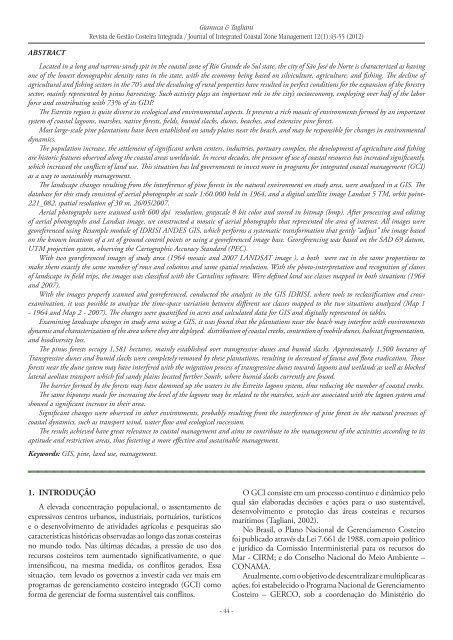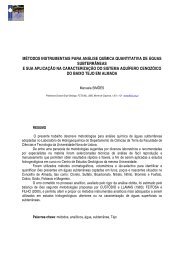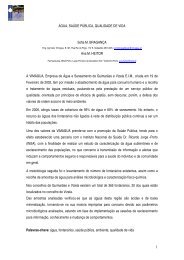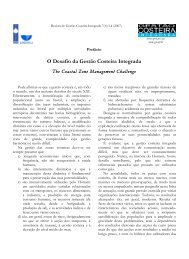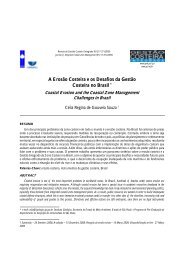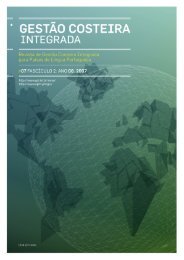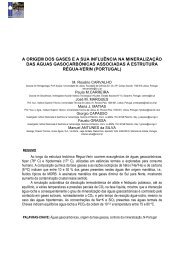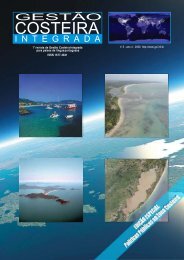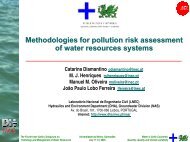Create successful ePaper yourself
Turn your PDF publications into a flip-book with our unique Google optimized e-Paper software.
ABSTRACT<br />
Gianuca & Tagliani<br />
Revista de Gestão Costeira Integrada / Journal of Integrated Coastal Zone Management 12(1):43-55 (2012)<br />
Located in a long and narrow sandy spit in the coastal zone of Rio Grande do Sul state, the city of São José do Norte is characterized as having<br />
one of the lowest demographic density rates in the state, with the economy being based on silviculture, agriculture, and fishing. The decline of<br />
agricultural and fishing sectors in the 70’s and the devaluing of rural properties have resulted in perfect conditions for the expansion of the forestry<br />
sector, mainly represented by pinus harvesting. Such activity plays an important role in the city’s socioeconomy, employing over half of the labor<br />
force and contributing with 73% of its GDP.<br />
The Estreito region is quite diverse in ecological and environmental aspects. It presents a rich mosaic of environments formed by an important<br />
system of coastal lagoons, marshes, native forests, fields, humid slacks, dunes, beaches, and extensive pine forest.<br />
Most large-scale pine plantations have been established on sandy plains near the beach, and may be responsible for changes in environmental<br />
dynamics.<br />
The population increase, the settlement of significant urban centers, industries, portuary complex, the development of agriculture and fishing<br />
are historic features observed along the coastal areas worldwide. In recent decades, the pressure of use of coastal resources has increased significantly,<br />
which increased the conflicts of land use. This situation has led governments to invest more in programs for integrated coastal management (GCI)<br />
as a way to sustainably management.<br />
The landscape changes resulting from the interference of pine forests in the natural environment on study area, were analyzed in a GIS. The<br />
database for this study consisted of aerial photographs at scale 1:60.000 held in 1964, and a digital satellite image Landsat 5 TM, orbit point-<br />
221_082, spatial resolution of 30 m, 26/05/2007.<br />
Aerial photographs were scanned with 600 dpi resolution, grayscale 8 bit color and stored in bitmap (bmp). After processing and editing<br />
of aerial photographs and Landsat image, we constructed a mosaic of aerial photographs that represented the area of interest. All images were<br />
georeferenced using Resample module of IDRISI ANDES GIS, which performs a systematic transformation that gently “adjust” the image based<br />
on the known locations of a set of ground control points or using a georeferenced image base. Georeferencing was based on the SAD 69 datum,<br />
UTM projection system, observing the Cartographic Accuracy Standard (PEC).<br />
With two georeferenced images of study area (1964 mosaic and 2007 LANDSAT image ), a both were cut in the same proportions to<br />
make them exactly the same number of rows and columns and same spatial resolution. With the photo-interpretation and recognition of classes<br />
of landscape in field trips, the images was classified with the Cartalinx software. Were defined land use classes mapped in both situations (1964<br />
and 2007).<br />
With the images properly scanned and georeferenced, conducted the analysis in the GIS IDRISI, where tools to reclassification and crossexamination,<br />
it was possible to analyze the time-space variation between different use classes mapped to the two situations analyzed (Map 1<br />
- 1964 and Map 2 - 2007). The changes were quantified in acres and calculated data for GIS and digitally represented in tables.<br />
Examining landscape changes in study area using a GIS, it was found that the plantations near the beach may interfere with environments<br />
dynamic and characterization of the area where they are deployed. distribution of coastal creeks, contention of mobile dunes, habitat fragmentation,<br />
and biodiversity loss.<br />
The pinus forests occupy 1,581 hectares, mainly established over transgressive dunes and humid slacks. Approximately 1,500 hectares of<br />
Transgressive dunes and humid slacks were completely removed by these plantations, resulting in decreased of fauna and flora eradication. Those<br />
forests near the dune system may have interfered with the migration process of transgressive dunes towards lagoons and wetlands as well as blocked<br />
lateral aeolian transport which fed sandy plains located further South, where humid slacks currently are found.<br />
The barrier formed by the forests may have dammed up the waters in the Estreito lagoon system, thus reducing the number of coastal creeks.<br />
The same hipotesys made for increasing the level of the lagoons may be related to the marshes, wich are associated with the lagoon system and<br />
showed a significant increase in their area.<br />
Significant changes were observed in other environments, probably resulting from the interference of pine forest in the natural processes of<br />
coastal dynamics, such as transport wind, water flow and ecological succession.<br />
The results achieved have great relevance to coastal management and aims to contribute to the management of the activities according to its<br />
aptitude and restriction areas, thus fostering a more effective and sustainable management.<br />
Keywords: GIS, pine, land use, management.<br />
1. INTRODUÇÃO<br />
A elevada concentração populacional, o assentamento de<br />
expressivos centros urbanos, industriais, portuários, turísticos<br />
e o desenvolvimento de atividades agrícolas e pesqueiras são<br />
características históricas observadas ao longo das zonas costeiras<br />
no mundo todo. Nas últimas décadas, a pressão de uso dos<br />
recursos costeiros tem aumentado significativamente, o que<br />
intensificou, na mesma medida, os conflitos gerados. Essa<br />
situação, tem levado os governos a investir cada vez mais em<br />
programas de gerenciamento costeiro integrado (GCI) como<br />
forma de gerenciar de forma sustentável tais conflitos.<br />
O GCI consiste em um processo contínuo e dinâmico pelo<br />
qual são elaboradas decisões e ações para o uso sustentável,<br />
desenvolvimento e proteção das áreas costeiras e recursos<br />
marítimos (Tagliani, 2002).<br />
No Brasil, o Plano Nacional de Gerenciamento Costeiro<br />
foi publicado através da Lei 7.661 de 1988, com apoio político<br />
e jurídico da Comissão Interministerial para os recursos do<br />
Mar - CIRM; e do Conselho Nacional do Meio Ambiente –<br />
CONAMA.<br />
Atualmente, com o objetivo de descentralizar e multiplicar as<br />
ações, foi estabelecido o Programa Nacional de Gerenciamento<br />
Costeiro – GERCO, sob a coordenação do Ministério do<br />
- 44 -


